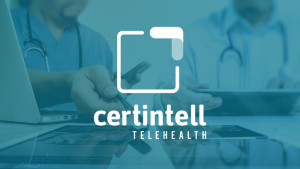E-visits are an extremely accessible and affordable form of telehealth that benefits patients and providers. E-visits simplify workflows, decrease costs and improve patient experiences. They should be a staple in care plans for your community. Here’s how to implement them.
Overview
CMS defines E-visits as “non face-to-face patient-initiated digital communications that require a clinical decision that otherwise typically would have been provided in the office.”1 By definition, e-visits are not telehealth services, but rather their own separate entity. In recent years, CMS has expanded the types of providers eligible to be reimbursed.
E-visits may seem like a tricky thing to implement, but with the right knowledge, systems and partners, it can be a seamless process.
Setup
An e-visit is normally an asynchronous form of patient/provider communication. The issue addressed during the visit is acute at most. In a typical setting, a patient takes the initiative and logs onto a patient portal, answers a series of questions about their condition. The provider then takes these answers into consideration with the patient’s EMR and then makes a diagnosis, prescribes needed treatment and responds to the patient within a few hours. In some instances, to be reimbursable, an e-visit cannot occur within fewer than seven days of a face-to-face encounter.¹ E-visits are differentiated from emails, because e-visits require three primary elements²:
- History taking
- Diagnosis
- Intervention
Supporting Underserved Populations
Benefits of using e-visits exceed more than just one. For example, telehealth video visits may not always be a form of virtual care that is accessible to all or most patients.
“Lower-income patients may face unique barriers to accessing video visits, while federally qualified health centers may lack resources to develop the necessary infrastructure to conduct video telehealth,” said this researcher at the RAND Corporation. “These are important considerations for policymakers if telehealth continues to be widely embraced in the future.”
Major Benefits
This is where e-visits can help supplement your efforts. E-visits are simple and efficient. The only infrastructure needed is a secure portal, integrated with an EMR. This means all the patient has to do is have a viable internet connection to be able to access it. Through e-visits, a patient answers a series of structured questions, to which the provider can then respond appropriately. This then eliminates the need for video capabilities and frees up opportunities for patients to use regular devices without them. For example, consider an underserved patient goes to their local library for a secure setting and internet connection, and does not have access to a smartphone with video capabilities. With e-visits, that patient is able to continue to go to find a public and secure internet connection, and express their concerns to their provider. Privacy isn’t as big of a concern in this situation either because speech isn’t required. The patient can then revisit the portal when their schedule allows and take appropriate action.
This article by the Daily Yonder predicts libraries will increasingly become hubs where rural patients will be able to easily obtain virtual care services, such as e-visits. As a result, the combination of the service and the location in which it is provided eliminate many barriers for patients.
“Library staff can play an important role supporting the health information needs of their community,” the author states. “There are medical databases they can learn how to use. They can be trained to act in an adjunct capacity…Telehealth is being touted as a great potential equalizer in the battle for healthcare equity. Broadband and libraries are two main vehicles enabling communities to deliver that telehealth.”
E-visits could also be considered as a tactic in reducing trips to the ER. Sometimes, underserved patients frequent ER rooms for medical concerns that do not necessitate an emergency visit. However, the ER may be the only accessible venue of care for these patients. With the accessibility e-visits provide, the number of emergency department visits could be slashed. This saves everyone money, especially since out-of-pocket costs for e-visits average $25 for general consultations and $25-$45 for specialty consultations.³
Not to mention time spent is crucial to these underserved patients, who may not be so fortunate to have extended work flexibilities in their schedules. A normal in-office encounter averages fifteen minutes, excluding waiting time for the patient. E-visits’ time to completion averages around five minutes.
E-visits’ time to completion averages around five minutes.
Case Study: Michigan Medicine
Michigan Medicine implemented e-visits in 2017. The health system’s experience with e-visits confirms that it improves the lives of both patients and providers. From 2017 to 2020, 6,000 e-visits were conducted at Michigan Medicine, which saved patients more than 80,000 miles worth of travel (the equivalent to more than four trips around the earth!)³
One patient at Michigan Medicine stated, “I probably would have waited a few more days to see my regular physician or have gone to urgent care after hours as my schedule wouldn’t have allowed me to go into an office.” This statement alone shows how crucial accessible and timely modalities of care can be to keeping patients healthy.
The benefits of e-visits are not exclusive to primary care, but also extend into specialty care. CMS is allowing more specialty physicians the flexibility to bill for these transformative services. In a most recent example, CMS allowed physical therapists to start billing e-visits in January 2021. More initiatives like these are sure to come as models of care delivery continue to evolve.⁴
Tips for Implementing E-Visits
- Use the EMR to Maximize Clinical Reasoning: A patient may report a complaint that strays from previously discussed concerns. Using the EMR helps the provider decrease gaps in memory and form connections between what has happened in the past and what is happening now, if there are any.⁵
- Use Subjective Interviewing Skills: Data is always helpful in detecting abnormalities. However, sometimes it’s helpful to discover the drivers behind those numbers, which often come from a patient’s lived experience. Ask them open ended questions surrounding their life, but also related to their health, that might help you gauge the full picture. A provider should also ask most of the same questions or observations they would in a clinic (e.g. the nature and severity of pain).⁵
- Partner with community-based organizations (CBOs): Organizations designed around supporting community needs can be transformative in your efforts to improve population health. Oftentimes, partnering with CBOs can be a way to supplement lackluster funding from government agencies. CBOs have the resources and infrastructure to help you build healthier communities and promote new health initiatives.
“When health care companies pay community-based organizations to achieve outcomes, everybody wins: The recipients of the services are healthier and happier, health care spending decreases, and community-based organizations have service contracts that provide the solid financial platform they need to fully meet their missions,” says this article from Stat News.
Billing for E-Visits
Clinicians who can independently bill Medicare for evaluation and management services are allowed to bill for the following codes⁶:
CPT code 99421:
Online digital evaluation and management service, for an established patient, for up to 7 days, cumulative time during the 7 days; 5–10 minutes
CPT code 99422:
Online digital evaluation and management service, for an established patient, for up to 7 days cumulative time during the 7 days; 11– 20 minutes
CPT code 99423:
Online digital evaluation and management service, for an established patient, for up to 7 days, cumulative time during the 7 days; 21 or more minutes.
Clinicians who are not permitted to independently bill for evaluation and management visits (ex: occupational therapists, speech language pathologists, clinical psychologists) can also furnish e-visits by billing the following codes:
HCPCS code G2061:
Qualified non-physician healthcare professional online assessment and management, for an established patient, for up to seven days. Time over the seven days accumulates to 5-10 minutes.
HCPCS code G2062:
Qualified non-physician healthcare professional online assessment and management service, for an established patient, for up to seven days. Time over the seven days accumulates to 11–20 minutes.
HCPCS code G2063:
Qualified non-physician qualified healthcare professional assessment and management service, for an established patient, for up to seven days. Time over the seven days accumulates to 21 or more minutes.
How We Can Help:
Implementing e-visits in your community can be done quickly and efficiently with the right tools, resources and partners. Certintell provides you everything you need to launch an e-visit program within days. A secure, HIPAA-compliant portal is at your clinic’s disposal to interact with patients, as well as to review and update EMRs. We’ll even help with patient education on how to access the portal.
If you find your e-visit prompts further investigation, the same portal can be used to conduct telehealth visits. With Certintell, everything works together for a seamless virtual care experience.
SOURCES:
¹ American Physical Therapy Association. “Furnishing and Billing E-Visits: Addressing Your Questions News.” APTA, 18 Mar. 2020, www.apta.org/news/2020/03/18/furnishing-and-billing-e-visits-addressing-your-questions.
² Mehrotra, Ateev, et al. “Characteristics of Patients Who Seek Care via EVisits Instead of Office Visits.” NCBI, Telemedicine Journal and E-Health, 19 July 2013, www.ncbi.nlm.nih.gov/pmc/articles/PMC3699891.
³ “Ready for E-Visits? How Clinicians Can Make Their Practice More Efficient, Effective.” Michigan Medicine Headlines, 20 Jan. 2020, mmheadlines.org/2020/01/ready-for-e-visits-how-clinicians-can-make-their-practice-more-efficient-effective.
⁴ “Quick Guide to Using E-Visits by PTs.” APTA, 1 Jan. 2021, www.apta.org/your-practice/practice-models-and-settings/telehealth-practice/quick-guide-to-using-e-visits-by-pts.
⁵ Parsons, Andy. “4 Tips for Conducting Successful E-Visits.” MedBridge Blog, 14 July 2020, www.medbridgeeducation.com/blog/2020/04/4-tips-for-conducting-successful-e-visits.
⁶ Center for Medicaid and Medicare Services. “MEDICARE TELEMEDICINE HEALTH CARE PROVIDER FACT SHEET | CMS.” CMS, 17 Mar. 2020, www.cms.gov/newsroom/fact-sheets/medicare-telemedicine-health-care-provider-fact-sheet.
RELATED ARTICLES



